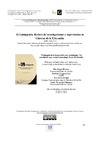Please use this identifier to cite or link to this item:
https://accedacris.ulpgc.es/jspui/handle/10553/70291
| DC Field | Value | Language |
|---|---|---|
| dc.contributor.author | López Meneses, Eloy | en_US |
| dc.contributor.author | Vázquez-Cano, Esteban | en_US |
| dc.contributor.author | Fernández Márquez, Esther | en_US |
| dc.date.accessioned | 2020-02-14T13:10:30Z | - |
| dc.date.available | 2020-02-14T13:10:30Z | - |
| dc.date.issued | 2019 | en_US |
| dc.identifier.issn | 2386-3374 | en_US |
| dc.identifier.uri | https://accedacris.ulpgc.es/handle/10553/70291 | - |
| dc.description.abstract | La investigación surge de la directriz marcada por el proyecto: “Formación didáctica en Cloud Computing: competencias digitales, estrategias didácticas y e-actividades con tecnologías web 2.0. en el EEES”, financiado por el Vicerrectorado de Docencia y Convergencia Europea de la Universidad Pablo de Olavide (UPO). Se presenta un estudio diacrónico en el que se analizan 292 concepciones de estudiantes sobre las fortalezas y debilidades de las tecnologías de la información y la comunicación en escenarios socioeducativos y servicios sociales correspondientes a los cursos académicos 2015/2016 a 2017/2018 de las titulaciones de Grado en Educación Social y el Doble Grado en Trabajo Social y Educación Social en la UPO. Entre los resultados resaltan un total de 44 ventajas: incorporar al aula diferentes metodologías (12%), facilitar la comunicación (11%), favorecer la motivación (10%) y entre los inconvenientes: problemas de salud (15%), distracción y aislamiento (14%) e información poco fiable (11%). | en_US |
| dc.description.abstract | The research emerges from the guidelines marked by the Project: “Didactic Training in Cloud Computing: digital competences, didactic strategies and e-activities with web 2.0 technologies in the EHEA”, funded by the Vice-Rector for Teaching and European Convergence of the Pablo de Olavide University (UPO). A diachronic study is presented in which 292 student conceptions about the strengths and weaknesses of the information and communication technologies in socio-educational settings and social services corresponding to the academic courses 2015/2016 to 2017/2018 of the Degree in Social Education and the Double Degree in Social Work and Social Education at UPO. Among the results, we can highlight a total of 44 advantages: the incorporation of different methodologies into the classroom (12%), the facility to communicate (11%), the encouragement of motivation (10%) and among the drawbacks: the health problems (15%), the distraction and isolation (14%) and the unreliable information (11%). | en_US |
| dc.language | spa | en_US |
| dc.relation.ispartof | El Guiniguada | en_US |
| dc.source | El Guiniguada [ISSN 0213-0610], v. 28, p. 76-92 | en_US |
| dc.subject | 58 Pedagogía | en_US |
| dc.subject | 531204 Educación | en_US |
| dc.subject | 120310 Enseñanza con ayuda de ordenador | en_US |
| dc.subject.other | Educación Superior | en_US |
| dc.subject.other | Innovación | en_US |
| dc.subject.other | Tecnología de la información y la comunicación | en_US |
| dc.subject.other | Aprendizaje activo | en_US |
| dc.subject.other | Sociedad de la información | en_US |
| dc.subject.other | Higher Education | en_US |
| dc.subject.other | Innovation | en_US |
| dc.subject.other | Information and communication technologies | en_US |
| dc.subject.other | Active learning | en_US |
| dc.subject.other | Information society | en_US |
| dc.title | Pedagogía de la innovación con tecnologías. Un estudio de caso en la Universidad Pablo de Olavide | en_US |
| dc.title.alternative | Pedagogy of innovation with technology. A case study at the Pablo de Olavide University | en_US |
| dc.type | info:eu-repo/semantics/article | en_US |
| dc.type | Article | en_US |
| dc.identifier.doi | 10.20420/ElGuiniguada.2019.267 | en_US |
| dc.investigacion | Artes y Humanidades | en_US |
| dc.type2 | Artículo | en_US |
| dc.utils.revision | Sí | en_US |
| dc.identifier.ulpgc | Sí | es |
| dc.description.sellofecyt | Sello FECYT | |
| dc.description.esci | ESCI | |
| dc.description.dialnetimpact | 0,0 | |
| dc.description.dialnetq | Q3 | |
| dc.description.erihplus | ERIH PLUS | |
| item.fulltext | Con texto completo | - |
| item.grantfulltext | open | - |
| Appears in Collections: | Artículos | |
Page view(s)
190
checked on Sep 23, 2023
Download(s)
406
checked on Sep 23, 2023
Google ScholarTM
Check
Altmetric
Share
Export metadata
Items in accedaCRIS are protected by copyright, with all rights reserved, unless otherwise indicated.
